
Van is a city in eastern Turkey's Van Province, on the eastern shore of Lake Van. It is the capital and largest city of Van Province.

Taksim Square, situated in Beyoğlu in the European part of Istanbul, Turkey, is a major tourist and leisure district famed for its restaurants, shops, and hotels. It is considered the heart of modern Istanbul, with the central station of the Istanbul Metro network. Taksim Square is also the location of the Republic Monument which was crafted by Pietro Canonica and inaugurated in 1928. The monument commemorates the 5th anniversary of the foundation of the Republic of Turkey in 1923, following the Turkish War of Independence.
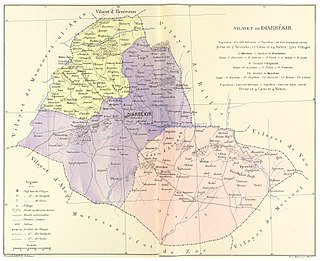
The Vilayet of Diyâr-ı Bekr was a first-level administrative division (vilayet) of the Ottoman Empire, wholly located within what is now modern Turkey. The vilayet extended south from Palu on the Euphrates to Mardin and Nusaybin on the edge of the Mesopotamian plain. After the establishment of Republic of Turkey in 1923, the region was incorporated into the newly created state.

Büyükada, meaning "Big Island" in Turkish, is the largest of the Princes' Islands in the Sea of Marmara, near Istanbul, with an area of about 2 square miles. It is officially a neighbourhood in the Adalar (Islands) district of Istanbul Province, Turkey.

Mardin is a city and seat of the Artuklu District of Mardin Province in Turkey. It is known for the Artuqid architecture of its old city, and for its strategic location on a rocky hill near the Tigris River.

Siirt is a city in the Siirt District of Siirt Province in Turkey. It had a population of 160,340 in 2021.

Iğdır is a city in the Eastern Anatolia Region of Turkey. It is the seat of Iğdır Province and Iğdır District. Its population is 101,700 (2022).

Midyat is a town in the Midyat District of Mardin Province in Turkey. It had a population of 83,148 in 2021.

Silvan is a city and district in the Diyarbakır Province of Turkey. Its population is 41,451.

Balat is in the old city on the European side of Istanbul, on the western shore of the Golden Horn, sandwiched between Fener and Ayvansaray. Historically, it was the centre of the Jewish community in Istanbul.

See History of Turkey. See also the Hittites, Sultanate of Rum, Ottoman Empire and Republic of Turkey.

The Cathedral of the Holy Cross on Aghtamar Island, in Lake Van in eastern Turkey, is a medieval Armenian Apostolic cathedral, built as a palatine church for the kings of Vaspurakan and later serving as the seat of the Catholicosate of Aghtamar.
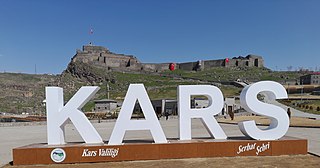
The Castle of Kars is a former fortification located in Kars, Turkey. It is also known under the name Iç Kale.
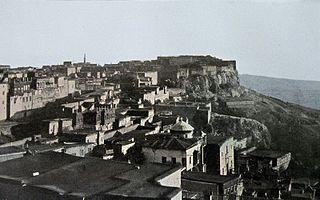
Harpoot or Kharberd is an ancient town located in the Elazığ Province of Turkey. It now forms a small district of the city of Elazığ. In the late Ottoman period, it fell under the Mamuret-ul-Aziz Vilayet. Artifacts from around 2000 BC have been found in the area. The town is famous for its Harput Castle, and incorporates a museum, old mosques, a church, and the Buzluk (Ice) Cave. Harput is about 700 miles (1,100 km) from Istanbul.
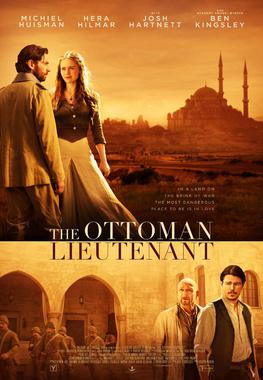
The Ottoman Lieutenant is a Turkish-American romantic war drama film directed by Joseph Ruben and written by Jeff Stockwell. The film stars Michiel Huisman, Hera Hilmar, Josh Hartnett and Ben Kingsley. The film was released widely on March 10, 2017.
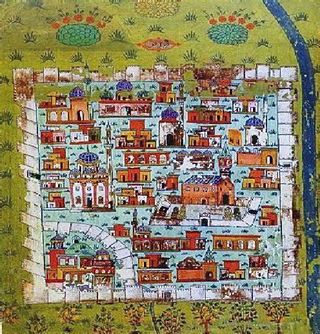
The history of Diyarbakır, one of the largest cities in southeastern Turkey and a metropolitan municipality of Turkey, spans millennia. Diyarbakır is situated on the banks of the Tigris River. The city was first mentioned by Assyrian texts as the capital of a Semitic kingdom. It was ruled by a succession of nearly every polity that controlled Upper Mesopotamia, including the Mitanni, Arameans, Assyrians, Urartu, Armenians, Achaemenid Persians, Medes, Seleucids, and Parthians. The Roman Republic gained control of the city in the first century BC, by which stage it was named "Amida". Amida was then part of the Christian Byzantine Empire until the seventh-century Muslim conquest, after which a variety of Muslim polities gave way to the Ottoman Empire in the 16th century. It has been part of the Republic of Turkey since the dissolution of the Ottoman Empire in the early 20th century.

Zerzevan Castle, also known as Samachi Castle, is a ruined Eastern Roman castle, a former important military base, in Diyarbakır Province, southeastern Turkey. Archaeological excavations at the site revealed the existence of underground structures, among them a temple of Mithraism, a mystery religion. The castle was used as a civilian settlement between the 1890s and the 1960s. The site is partly open to tourism.

Harput Castle, also known as Milk Castle, is a castle located in the historical Harput neighborhood within the borders of the current Elazığ Province, Turkey. It was built by the Urartians on a rectangular plan. The castle consists of two parts, internal and external. According to legend, a scarcity of water and abundance of milk during its construction meant that milk was added to the castle's mortar, leading to it being sometimes called "Milk Castle".
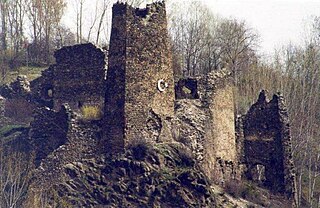
Şavşat Castle or Satle Castle is a castle in Şavşat district in Artvin Province in Turkey.
Sarkis Elyas Lole, also known as Levon, was a prominent Armenian architect of the Ottoman Empire. Lole was the chief architect of Mardin and responsible for much of the late nineteenth- to early twentieth-century architecture of the city, as well as in neighboring Diyarbakır.





















